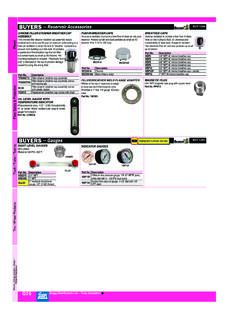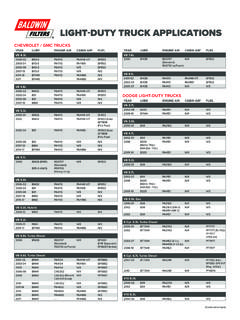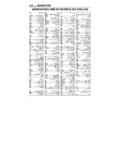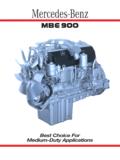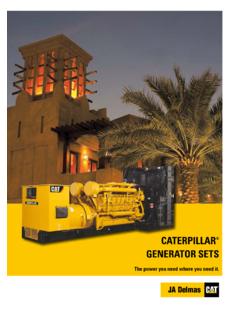Transcription of Service Bulletin Cummins® Engine Oil and Oil Analysis ...
1 Service Bulletin Number Date 3810340-06 11-MAY-2007 Design Application Market Application All All Service Bulletin cummins Engine Oil and Oil Analysis Recommendations Section 1: Diesel Engine Oil Recommendations 2 Engines with EGR and Aftertreatment 3 Engines with EGR, but without Aftertreatment 3 Engines without EGR 3 Minimum Requirements 3 cummins Recommended SAE Oil Viscosity Grades 3 Synthetic Oils 4 Re-refined Oils 4 Friction Modifiers 4 Break-in Oils 4 Drain Intervals 4 Monograde Oils 4 Non-Classified Oils 4 Section 2: Natural Gas Engine Oil Recommendations 5 Section 3: Functions Of Engine Oil 5 Lubrication 5 Extreme Pressure Wear Control 5 Cleaning 5 Protection 6 Cooling 6 Sealing 6 Shock-Damping 6 Hydraulic Action 6 Oil Additives 6 Section 4: Viscosity 6 Oil Viscosity and Engine Performance 6 Viscosity Recommendations 7 Section 5: Oil Performance Classification 7 cummins Engineering Standards (CES) 7 Supplemental Friction Modifiers and Other Additives 7 Section 6: Oil Contamination 7 Oil Contaminants 7 Section 7: Oil Filtration 8 Oil Filter Design, Use, and Function 8 Filter Plugging 8 Section 8: Oil Change Intervals 9 Factors Used to Determine Oil Drain Intervals 9 Centinel Continuous Oil Change 9 Section 9: Used Oil Analysis 9 Oil Sample Collection 9 Contamination Check 10 Appendix A - Used Oil Analysis Applications 10 Contamination Checks 11 Evaluating Operating and Maintenance Intervals 11 Introduction This Service Bulletin outlines the proper application and maintenance of Engine oil for cummins engines.
2 The purpose of this Service Bulletin is to update and simplify cummins Inc. recommendations and guidelines for the end user. cummins Inc. recommends the use of a high quality, diesel Engine oil such as Valvoline Premium Blue or Valvoline Premium Blue Extreme Life or their equivalent, and high quality filters such as Fleetguard or their equivalent. cummins Inc. bases oil drain recommendations on oil performance classifications and duty cycle. Maintaining the correct oil and filter change interval is a vital factor in preserving the integrity of an Engine . Consult your Operation and Maintenance manual for detailed instructions on determining the oil change interval for your Engine . SECTION 1: DIESEL Engine OIL RECOMMENDATIONS CAUTION Use of CES 20081 oil in off-road engines operating on off-road fuel with higher sulfur content can result in severe Engine damage if the applicable drain intervals and recommendations are not followed.
3 See Table 3 for compatible fuel and oil combinations. CAUTION Failure to follow applicable drain intervals and recommendations in this Service Bulletin and the Operation and Maintenance Manual can result in severe Engine damage that might not be covered under warranty. cummins Inc. has established a number of cummins Engineering Standards (CES) which describe the performance levels of Engine oils that must be used in various engines. In addition, cummins Inc. works through the Engine Manufacturers Association (EMA) and with the many technical and marketing organizations responsible for lubricant quality around the world, to develop industry specifications that meet cummins Inc. requirements. Table 1 lists the cummins Engineering Standards and those North American and international performance classifications which most closely satisfy them.
4 Table 1: cummins Engineering Standards (CES) for Lubricants: CES Application North American Classification International Classification 20081 Heavy Duty and MidRange Engines with Exhaust Aftertreatment and 15 ppm Sulfur Diesel Fuel API-4 CJ-4 20078 Heavy Duty and MidRange Engines with EGR API CI-4 20077 Premium Oil for Heavy Duty and High Horsepower Engines outside North America without EGR See note 7 20076 Premium Oil for Heavy Duty and High Horsepower Engines without EGR in North America See note 6 20075 Minimum quality oil for MidRange engines without EGR in applications outside North America API CF-4/SG ACEA E-2 / E-3 JAMA 4 DH-120072 Standard oil for engines without EGR in all parts API CH-4 Global DHD-1 of the world ACEA E-5 20071 Standard oil for engines without EGR in all parts of the world API CH-4 API CH-4/SJ Global DHD-1 Categories not recommended 5
5 Do NOT Use API CA CB CC CD CE CG-4 ACEA E-1 1 American Petroleum Institute. 2 Developed by EMA, ACEA, JAMA. 3 ACEA = Association des Constructeurs European d' Association. 4 JAMA = Japanese Automobile Manufacturers Association. 5 Use of oils with only these designations poses an undue risk of Engine damage for engines designed to use more advanced oils, even when drastically shortened oil change intervals are followed. 6 CES 20076 adds the requirement of a 300 hour cummins M11 test to API CH-4. 7 CES 20077 Adds the requirement of a 300 hour test to ACEA E-5. Engines with EGR and Aftertreatment Engines using Exhaust Gas Recirculation (EGR) and Exhaust Aftertreatment must operate on Ultra-low Sulfur Diesel (15 ppm Sulfur). Use of oils meeting the requirements of CES-20081 will provide the longest maintenance intervals for the aftertreatment system.
6 For drain interval and maintenance interval recommendations, consult the Operation and Maintenance Manual for the particular Engine model and duty cycle. Engines with EGR, but without Aftertreatment Engines with Exhaust Gas Recirculation (EGR) can use lubricants meeting CES 20078 (API CI-4). For drain interval recommendations, consult the Operation and Maintenance Manual for the particular Engine model and duty cycle. CES 20081 (API Cj-4) can be used when 15 ppm sulfur fuel is also used. If oils meeting CES 20078 are not available, CES 20071, 20072, 20076 or 20077 can be used in EGR equipped engines at reduced drain intervals. Consult the Operation and Maintenance Manual for the particular Engine model and duty cycle for the detailed recommendations. Engines without EGR Oils meeting CES 20078 (API CI-4) are compatible with CES 20071, 20072, 20075, 20076, or 20077, and can be used where those oils are recommended.
7 Where they are available, oils meeting CES 20071, 20072, 20075, 20076 or 20077 can continue to be used in engines without EGR, as described in Table 1 above. Outside North America, where oils meeting CES 20076 or CES 20077 might not be available, cummins Inc. primary recommendation is for an oil meeting Global DHD-1, as jointly developed by EMA, ACEA, and JAMA. The oil suppliers are responsible for the quality and performance of their products. cummins Inc. recommends Engine oil with a normal ash content of to percent mass. Oils with higher ash contents, up to percent mass, can be used in areas where the sulfur content of the fuel is over percent mass. Limiting ash content is critical to prevention of valve and piston deposit formation. See to Fuels for cummins Engines, Bulletin Number 3379001, for more information regarding fuel sulfur content.
8 The values listed in the table below are guidelines only. The absolute value of these numbers will vary with the situation. CES 20078 and CES 20081 Oil Compatibility with 500 PPM and 15 PPM Sulfur Fuel Fuel Type Oil Type CES 20078 (CI-4) CES 20081 (CJ-4) 350 to 500 PPM Sulfur Fuel Yes No or reduced oil drain internal 15 PPM Sulfur Fuel Yes Yes Minimum Requirements For Heavy Duty engines (L, M, N, ISX and Signature) and high horsepower engines (QSK, QST series), API CF-4 oils can be used, but the drain interval must be reduced to 250 hours / 15,000 km (10,000 miles). For mid range engines (B, ISB, C, and ISC series) oil meeting CES 20075 can be used, but the drain interval must be reduced to 250 hours / 15,000 km (10,000 miles). cummins Inc. Recommended SAE Oil Viscosity Grades cummins Inc. primary recommendation is for the use of 15W40 multigrade for normal operation at ambient temperatures above -15 C [5 F].
9 The use of multigrade oil reduces deposit formation, improves Engine cranking in low temperature conditions, and increases Engine durability by maintaining lubrication during high temperature operating conditions. Since multigrade oils have been shown to provide approximately 30 percent lower oil consumption, compared with monograde oils, it is important to use multigrade oils to be certain your Engine will meet applicable emissions requirements. While the preferred viscosity grade is 15W-40, lower viscosity multigrades can be used in colder climates. See Figure 1: Recommended SAE Oil Viscosity Grades at Ambient Temperatures. Oils meeting API CI-4 and CJ-4 and a 10W30 viscosity grade, must meet a minimum High Temperature / High Shear viscosity of cSt., and ring wear / liner wear requirements of cummins Inc. and Mack tests.
10 Thus, they can by be used over a wider temperature range than 10W30 oils meeting older API performance classifications. As these oils will have directionally thinner oil films than 15W40 oils, top quality Fleetguard filters must be used above 20 C [70 F]. Some oil suppliers might claim better fuel economy for these oils. cummins Inc. can neither approve nor disapprove any product not manufactured by cummins Inc. These claims are between the customer and the oil supplier. Obtain the oil supplier's commitment that the oil will give satisfactory performance in cummins engines, or do not use the oil. WARNING An SAE 10W30 designation on a product is a viscosity designation only. This designation alone does not imply that the product meets cummins Inc. requirements. Only 10W30 oils with diesel performance credentials listed in table 1 can be used in cummins Engines if the reduced ambient temperature indicated in Figure 1 is observed.

